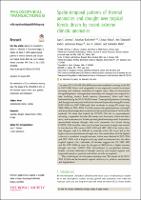Mostrar el registro sencillo del ítem
Spatio-temporal patterns of thermal anomalies and drought over tropical forests driven by recent extreme climatic anomalies
| dc.contributor.author | Jimenez, Juan C. | |
| dc.contributor.author | Barichivich, Jonathan | |
| dc.contributor.author | Mattar, Cristian | |
| dc.contributor.author | Takahashi, Ken | |
| dc.contributor.author | Santamaría-Artigas, Andrés | |
| dc.contributor.author | Sobrino, José A. | |
| dc.contributor.author | Malhi, Yadvinder | |
| dc.date.accessioned | 2020-01-30T19:32:20Z | |
| dc.date.available | 2020-01-30T19:32:20Z | |
| dc.date.issued | 2018-08-23 | |
| dc.identifier.citation | Jimenez Juan C., Barichivich Jonathan, Mattar Cristian y otros (2018) Spatio-temporal patterns of thermal anomalies and drought over tropical forests driven by recent extreme climatic anomalies373Phil. Trans. R. Soc. B. https://doi.org/10.1098/rstb.2017.0300 | es_PE |
| dc.identifier.uri | https://hdl.handle.net/20.500.12542/226 | |
| dc.description.abstract | The recent 2015– 2016 El Niño (EN) event was considered as strong as the EN in 1997–1998. Given such magnitude, it was expected to result in extreme warming and moisture anomalies in tropical areas. Here we characterize the spatial patterns of temperature anomalies and drought over tropical forests, including tropical South America (Amazonia), Africa and Asia/Indonesia during the 2015–2016 EN event. These spatial patterns of warming and drought are compared with those observed in previous strong EN events (1982–1983 and 1997–1998) and other moderate to strong EN events (e.g. 2004–2005 and 2009–2010). The link between the spatial patterns of drought and sea surface temperature anomalies in the central and eastern Pacific is also explored. We show that indeed the EN2015–2016 led to unprecedented warming compared to the other EN events over Amazonia, Africa and Indonesia, as a consequence of the background global warming trend. Anomalous accumulated extreme drought area over Amazonia was found during EN2015–2016, but this value may be closer to extreme drought area extents in the other two EN events in 1982–1983 and 1997– 1998. Over Africa, datasets disagree, and it is difficult to conclude which EN event led to the highest accumulated extreme drought area. Our results show that the highest values of accumulated drought area over Africa were obtained in 2015–2016 and 1997–1998, with a long-term drying trend not observed over the other tropical regions. Over Indonesia, all datasets suggest that EN 1982– 1983 and EN 1997–1998 (or even the drought of 2005) led to a higher extreme drought area than EN2015 –2016. Uncertainties in precipitation datasets hinder consistent estimates of drought severity over tropical regions, and improved reanalysis products and station records are required. This article is part of a discussion meeting issue ‘The impact of the 2015/2016 El Niño on the terrestrial tropical carbon cycle: patterns, mechanisms and implications’. | es_US |
| dc.format | application/pdf | es_PE |
| dc.language.iso | eng | es_PE |
| dc.publisher | The Royal Society | es_PE |
| dc.relation.ispartof | urn:issn:1097-0088 | |
| dc.rights | Reconocimiento - No comercial - Sin obra derivada (CC BY-NC-ND) | es_PE |
| dc.rights | info:eu-repo/semantics/openAccess | es_PE |
| dc.rights.uri | https://creativecommons.org/licenses/by-nc-nd/4.0/ | es_PE |
| dc.source | Repositorio Institucional - SENAMHI | es_PE |
| dc.source | Servicio Nacional de Meteorología e Hidrología del Perú | es_PE |
| dc.subject | Bosque Tropical | en_US |
| dc.subject | Zona Tropical | en_US |
| dc.subject | Climatología | en_US |
| dc.subject | ENSO | en_US |
| dc.title | Spatio-temporal patterns of thermal anomalies and drought over tropical forests driven by recent extreme climatic anomalies | en_US |
| dc.type | info:eu-repo/semantics/article | es_PE |
| dc.identifier.isni | 0000 0001 0746 0446 | |
| dc.description.peerreview | Por pares | es_PE |
| dc.identifier.doi | https://doi.org/10.1098/rstb.2017.0300 | |
| dc.identifier.journal | International Journal of Climatology | es_PE |
| dc.subject.ocde | https://purl.org/pe-repo/ocde/ford#1.05.09 | es_PE |
| dc.subject.ocde | https://purl.org/pe-repo/ocde/ford#1.05.10 | es_PE |
| dc.subject.sinia | variabilidad climatica - Clima y Eventos Naturales | es_PE |
| dc.type.sinia | text/publicacion cientifica | es_PE |
| dc.identifier.url | https://hdl.handle.net/20.500.12542/226 | |
| dc.identifier.url | https://hdl.handle.net/20.500.12542/226 |
Ficheros en el ítem
Este ítem aparece en la(s) siguiente(s) colección(es)
-
Artículo científico [176]









